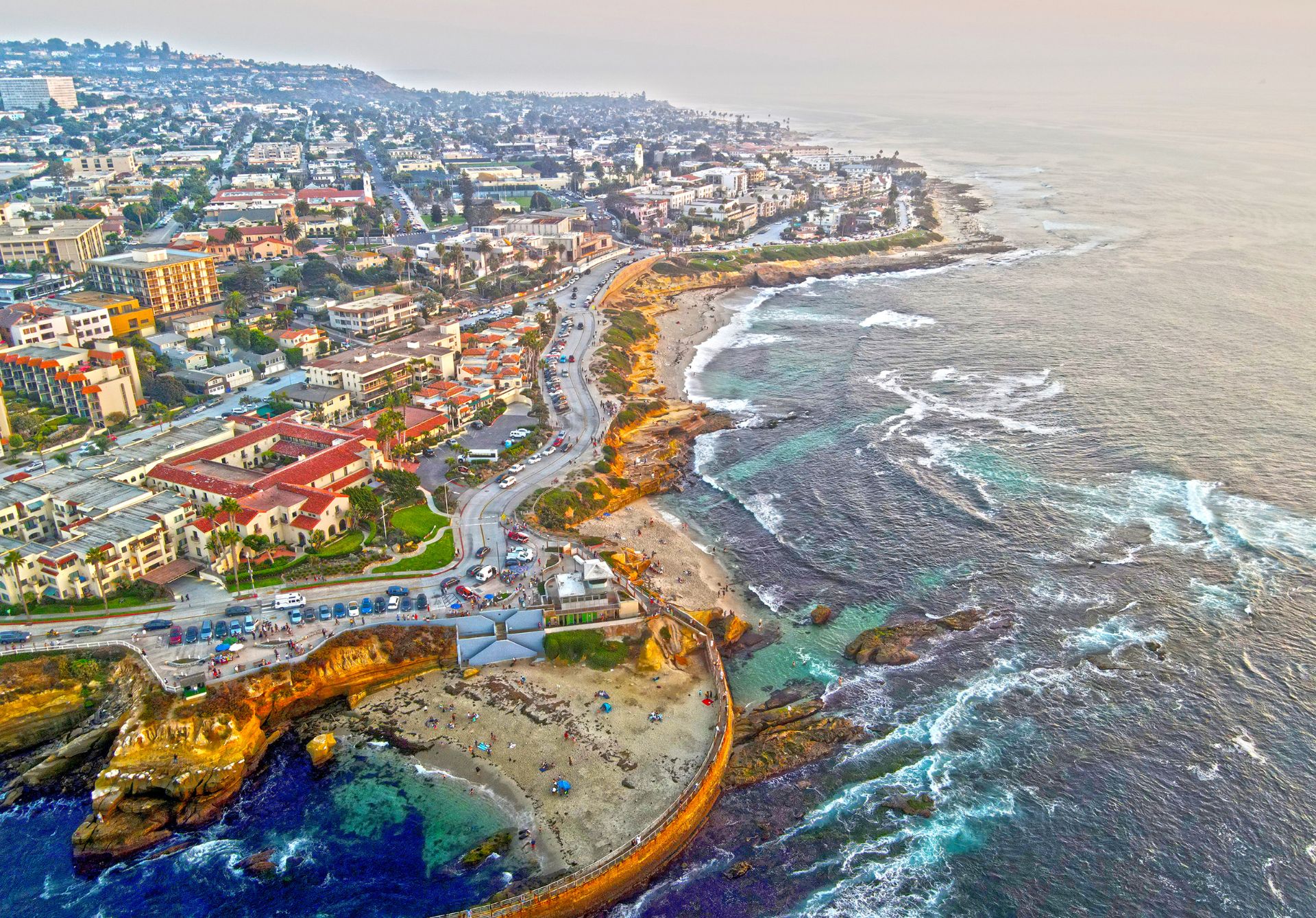Nestled along the picturesque coastline of Southern California, La Jolla Cove stands as a testament to nature’s beauty and San Diego’s allure. This small, scenic cove has captivated visitors for generations with its stunning views, rich marine life, and unique coastal ecosystem. In this article, we’ll explore the many facets of La Jolla Cove, from its geological formation to its role in local culture and conservation efforts.
A Geological Marvel
La Jolla Cove’s striking beauty is no accident of nature. Formed over millions of years, the cove is the result of complex geological processes that have shaped the San Diego coastline. The area’s distinctive cliffs are composed primarily of sedimentary rocks, including sandstone and shale, which have been eroded by the relentless action of waves and wind.
Geologists estimate that the cove began taking its current form approximately 75 million years ago during the Late Cretaceous period. The ongoing process of erosion continues to sculpt the coastline, creating the dramatic sea caves and rugged cliffs that define La Jolla Cove today.
Marine Biodiversity
One of La Jolla Cove’s most remarkable features is its rich marine ecosystem. The cove is part of the La Jolla Underwater Park Ecological Reserve, established in 1971 to protect the area’s diverse aquatic life. This protected status has allowed marine populations to thrive, making the cove a paradise for snorkelers, divers, and marine biologists alike.
Notable Species
Visitors to La Jolla Cove can expect to encounter a wide variety of marine life, including: Garibaldi fish: The bright orange state fish of California is a common sight in the cove’s waters. Sea lions and harbor seals: These charismatic mammals can often be seen sunbathing on the rocks or swimming in the cove. Leopard sharks: During the summer months, these docile sharks gather in large numbers in the shallow waters. California spiny lobster: These crustaceans inhabit the rocky crevices of the cove. Various species of colorful sea anemones, starfish, and sea urchins.
According to a 2022 survey conducted by the Scripps Institution of Oceanography, over 500 species of marine life have been documented in and around La Jolla Cove, making it one of the most biodiverse coastal areas in Southern California.
Recreational Activities
La Jolla Cove’s natural beauty and protected waters make it a popular destination for a variety of recreational activities. Some of the most popular pursuits include:
Swimming and Snorkeling
The calm, clear waters of the cove provide ideal conditions for swimming and snorkeling. With visibility often exceeding 30 feet, snorkelers can easily observe the vibrant marine life beneath the surface. Local tour operators offer guided snorkeling excursions for those looking to learn more about the cove’s ecosystem.
Scuba Diving
For more experienced aquatic enthusiasts, La Jolla Cove offers excellent scuba diving opportunities. The underwater topography includes kelp forests, rocky reefs, and sea caves, providing diverse habitats to explore. The La Jolla Canyon, which begins just offshore, plunges to depths of over 600 feet, attracting advanced divers from around the world.
Kayaking
Kayaking tours of the La Jolla sea caves have become increasingly popular in recent years. These guided excursions allow visitors to paddle along the coastline, exploring hidden coves and catching glimpses of marine life from a unique perspective.
Conservation Efforts and Challenges
While La Jolla Cove’s protected status has helped preserve its natural beauty and biodiversity, the area faces ongoing conservation challenges. The delicate balance between human enjoyment and environmental protection requires constant attention and management.
Water Quality
Maintaining water quality is a primary concern for local environmental groups and government agencies. Urban runoff and pollution from nearby developments can threaten the cove’s ecosystem. The San Diego Coastkeeper organization reports that while water quality in La Jolla Cove is generally good, there have been instances of elevated bacteria levels, particularly after heavy rains.
Human Impact
The popularity of La Jolla Cove as a tourist destination has led to concerns about the impact of human activity on the local wildlife. Efforts to educate visitors about responsible wildlife viewing and the importance of not disturbing marine animals have been implemented, including informational signage and increased ranger presence during peak seasons.
Climate Change
Like many coastal areas, La Jolla Cove is vulnerable to the effects of climate change. Rising sea levels and increased storm intensity could potentially alter the cove’s shoreline and impact its marine ecosystems. Local scientists from the Scripps Institution of Oceanography are actively monitoring these changes and working to develop strategies for long-term conservation.
Cultural Significance
Beyond its natural wonders, La Jolla Cove holds a special place in the cultural fabric of San Diego. The cove has been a source of inspiration for artists, writers, and photographers for generations. Its iconic beauty has been featured in countless postcards, travel brochures, and social media posts, helping to cement San Diego’s reputation as a coastal paradise.
The cove also plays a role in local traditions, such as the annual La Jolla Rough Water Swim, which has been held since 1916. This event draws swimmers from around the world and has become a beloved community celebration.
La Jolla Cove stands as a shining example of the natural beauty that has made San Diego a world-renowned destination. Its geological wonders, rich biodiversity, and recreational opportunities offer something for every visitor, from casual beachgoers to serious marine enthusiasts. However, the cove’s delicate ecosystem serves as a reminder of the need for responsible stewardship of our natural resources.
As we look to the future, the ongoing efforts to conserve and protect La Jolla Cove will be crucial in ensuring that this coastal gem continues to inspire and delight generations to come. By balancing human enjoyment with environmental preservation, we can hope to maintain the unique character and ecological importance of this remarkable slice of California coastline.

